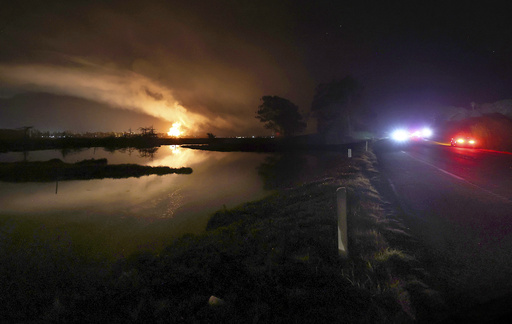
AUSTIN, Texas — A recent incident at one of the world’s largest battery facilities in Northern California has drawn attention due to a significant fire that engulfed a storage area containing tens of thousands of lithium batteries. These batteries are vital for storing power generated from renewable energy sources, which are increasingly essential in an era where electricity demands are shifting.
California and Texas lead the nation in deploying large-scale battery projects. This growth aims to enhance the reliability of the power supply in both states, particularly as they face the challenges posed by extreme weather events linked to climate change, which have resulted in electricity shortages and outages.
The fire erupted on Thursday at Vistra Energy’s battery site located in Moss Landing, about 80 miles south of San Francisco. The incident triggered the evacuation of approximately 1,700 individuals, led to the closure of a section of Highway 1, and produced significant flames along with considerable smoke. Authorities are currently investigating the cause of the fire.
While experts assert that lithium batteries are a crucial technology for reducing carbon emissions and improving grid reliability, local residents near the facility have voiced concerns regarding the potential repercussions of the incident.
In Texas, which is preparing for another wave of Arctic winter weather, officials have credited battery systems with helping to stabilize the state’s independent power grid. This was particularly crucial during a significant winter storm in 2021, which nearly caused a grid failure.
The popularity of battery storage solutions is on the rise in both California and Texas as both states face blackouts while trying to meet the energy needs of their large populations and various industries, including artificial intelligence and data centers.
Battery systems can capture excess energy produced by wind and solar sources for later use, providing a backup supply that helps maintain grid stability during peak demand, such as during heat waves when air conditioning usage surges.
The cost of lithium batteries has decreased substantially in recent years, enhancing their appeal. For instance, prices for electric vehicle batteries plummeted by around 90% from 2008 to 2022, according to data from the U.S. Department of Energy.
This reduction in costs has made utility-scale batteries more competitive when compared to some natural gas alternatives. Moreover, batteries can be activated and begin discharging power almost instantaneously in response to grid needs.
In Texas, the rapid deployment of utility-scale battery systems has led to an impressive addition of 5 gigawatts of storage capacity over the past year, helping the state manage its energy demands and avert blackouts. Factors like the 2021 blackout and the 2022 Inflation Reduction Act have spurred this growth. The state’s deregulated environment has facilitated the swift development of wind and solar projects, further driving the demand for battery storage.
“Power plants in Texas face much less administrative red tape,” noted Joshua Rhodes, an energy researcher from The University of Texas at Austin. “The state doesn’t impose regulations that slow down development.” However, many experts believe that the primary driver behind the rapid adoption of battery technology is its economic viability.
“I believe the narrative is less about regulatory issues and more about economic efficiency,” stated Jay Turner, an environmental science professor at Wellesley College. “The combination of reduced battery prices and renewable generation costs has rendered these technologies highly competitive.”
On the other hand, California has been at the forefront of pursuing clean energy initiatives for years, enacting ambitious clean energy standards back in 2002 that have been recognized by the International Energy Agency. As solar and wind energy have grown in popularity, concerns have emerged regarding the challenges of integrating this intermittent energy into the power grid.
Sally Benson, a professor of energy science engineering at Stanford University, recalled, “Even as early as 2005, there were predictions that exceeding 15% renewables on the grid would be untenable.” However, last year, California had over 11 gigawatts of utility-scale storage integrated into its grid.
Part of California’s proactive approach stems from a history of electricity shortages. For instance, the California Independent System Operator (CAISO) mandated rolling outages in 2020 due to excessive demand during a heat wave. Since that time, several gigawatts of storage capacity have been added, significantly contributing to the fact that CAISO has not had to order similar outages for nearly four years, as noted by Denise Grab, an energy policy researcher at UCLA.

